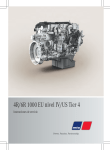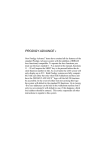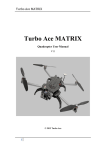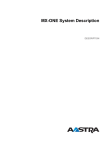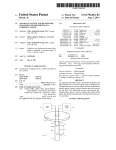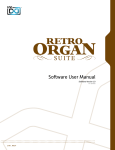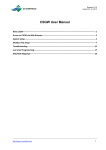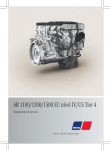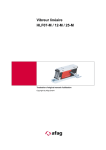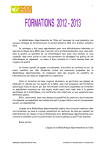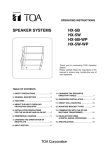Download Managing virtual computers simultaneously with static and dynamic
Transcript
US008918783B2 (12) United States Patent (10) Patent N0.: (45) Date of Patent: Mattiocco et a]. (54) MANAGING VIRTUAL COMPUTERS 2008/0004094 2008/0134176 2009/0217296 2009/0222560 2009/0228984 2009/0249329 2009/0300641 2009/0328225 2010/0306767 2013/0007279 SIMULTANEOUSLY WITH STATIC AND DYNAMIC DEPENDENCIES (75) Inventors: Attilio Mattiocco, Cassino (IT); Vincenzo Sciacca, Rome (IT) (73) Assignee: International Business Machines Corporation, Armonk, NY (US) A1 A1 A1 A1 A1 A1 A1 A1 A1 A1 US 8,918,783 B2 Dec. 23, 2014 1/2008 Mueller et al. 6/2008 Fitzgerald et al. 8/2009 Gebhart et a1. 9/2009 Gopisetty et al. 9/2009 Sterin 10/2009 Dash 12/2009 Friedman et al. 12/2009 Chambers et al. 12/2010 Dehaan 1/2013 Banjerjee et al. OTHER PUBLICATIONS (*) Notice: Subject to any disclaimer, the term of this patent is extended or adjusted under 35 U.S.C. 154(b) by 1647 days. (21) App1.No.: 12/167,010 (22) Filed: Jul. 2, 2008 (65) manual.pdf). “Cloning aVirtual Machine”; Workstation 5 User’s Manual; Nov. 15, 2006; p. 292-300; published by VMware, Inc., 3145 Porter Drive, Palo Alto, CA 94304 (available at: WWW.VII1W3I€.COIIl/Ple/W855i Prior Publication Data US 2009/0013321 A1 “Using Snapshots”; Workstation 5 User’s Manual; Nov. 15, 2006; p. 275-291; published by VMware, Inc., 3145 Porter Drive, Palo Alto, CA 94304 (available at: WWW.vmware.com/pdf/Ws5Simanualpdf). “The Snapshot Manager”; Workstation 5 User’s Manual; Nov. 15, 2006; p. 282-286; published by VMware, Inc., 3145 Porter Drive, Palo Alto, CA 94304 (available at: WWW.VII1W3I€.COIIl/Ple/W855i Jan. 8, 2009 manual.pdf). (30) Foreign Application Priority Data “Movie Record and Playback”; Workstation 5 User’s Manual; Nov. 15, 2006; p. 26-27; published by VMware, Inc., 3145 Porter Drive, Jul. 4, 2007 (FR) ................................ .. 07111753.5 Palo Alto, CA 94304 (available at: WWW.VII1W3I€.COIIl/Ple/W855i manual.pdf). (51) (52) Int. Cl. G06F 9/455 US. Cl. * cited by examiner (2006.01) CPC .................................... .. G06F 9/455 (2013.01) USPC (58) ............................................................ .. 718/1 Field of Classi?cation Search (57) None ABSTRACT Embodiments are disclosed for managing a plurality of vir tual computers in a virtual environment. According to one embodiment, a method includes creating a virtual group. The See application ?le for complete search history. (56) Primary Examiner * William B Partridge (74) Attorney, Agent, or Firm * Brevetto LaW Group References Cited virtual group includes a plurality of virtual computers having U.S. PATENT DOCUMENTS 7,313,512 B1 12/2007 Traut et a1. 7,467,378 B1* 12/2008 2007/0074199 A1* 2007/0250833 A1* a relevant characteristic. An action to perform on the virtual Sobel .......................... .. 717/168 3/2007 Schoenberg group is received, and the action is performed on each of the virtual computers in the virtual group. .. 717/168 25 Claims, 9 Drawing Sheets 10/2007 Araujo et al. ................... .. 718/1 22 24 Specify Action Display Groups Select Gmup(s) Check Static 28 26 Dependencies (SD) Si‘arl Rollback on Check Dynamic Machine Dependencies (DD) User System US. Patent Dec. 23, 2014 m US 8,918,783 B2 Sheet 2 0f 9 wm2w?agzwmh A mm m m 8Eg%, mEcm?uaE US. Patent Dec. 23, 2014 US 8,918,783 B2 Sheet 4 0f 9 mw / ww / A t/ gsenam?x wcmau wq A / “6gmme 5% .mm w US. Patent Dec. 23, 2014 US 8,918,783 B2 Sheet 5 0f 9 Emw mw \wm tvmuccw>mzo,m aw£5me 02 wm wm mm \\g3am9wa mm GE k A @$206m4e H@uQmwSQ mm mnawm EMwa US. Patent Dec. 23, 2014 US 8,918,783 B2 Sheet 6 0f 9 mw COME 32 ch w m mw mg E@3g0va oz 4 mm @ US. Patent Dec. 23, 2014 host machine Sheet 7 0f9 host machine host machine Virtuaiizatien framework (ag. VMWare) Actians Manager Fig. 7 US 8,918,783 B2 US. Patent Dec. 23, 2014 Sheet 8 0f9 Gmup US 8,918,783 B2 Actions Consistency h Manager Mgr mgmt agent Management (mgmt) framework (e.g.Ti\/Qii) host C] mm machine machine Virtuaiization framewch (9.9. VMWare) Fig! 8 C] host machine US. Patent Dec. 23, 2014 US 8,918,783 B2 Sheet 9 0f 9 g0” ow/ 0% ‘2 p.39 E?gm25 Amm<J @ vwmm@@ / MW 8man0 .,“A_ / @wmQ;20m§§ vw9wi‘a.im wk. 2* EGKiQO / Nb om .5 @ E, on US 8,918,783 B2 1 2 MANAGING VIRTUAL COMPUTERS SIMULTANEOUSLY WITH STATIC AND DYNAMIC DEPENDENCIES non-hierarchical manner, through one or more shared attributes known as group characteristics. The attributes con sidered within the group characteristics, may include inter alia: ?le attributes (e. g. detailing particular versions of ?les etc); registry attributes (single key or entire registry trees); CROSS-REFERENCE TO RELATED APPLICATIONS installed programs (detailing for example, the version or language of the programs); This application claims the bene?t of foreign priority to European Patent Application No. 071117535, ?led Jul. 4, screen Resolution attributes; and accounts information. For example, a virtual machine operating on a particular network (e.g., a local area network 2007. (LAN) which we will call LAN.sub.2), may employ the Win dows (trade mark) operating system in support of a database (DB) program (e. g., DB version 2). The virtual machine may BACKGROUND Embodiments of the disclosure relate to managing virtual computers in a virtual environment. A virtual environment be a member of three groups, such as, for example, a Windows (trade mark) group, a DB version 2 group and a LAN.sub.2 group. typically includes a large number of virtual machines residing on a small number of real servers. In this speci?cation, refer ences to computer and machine may be used to reference the same technology. In maintaining or operating a machine, it is often necessary to perform a number of operations (e.g. 2. Creating Groups 20 before groups are created, the embodiment may index the resources of the virtual machines in the virtual environment. Thus, the steps of indexing the resources may be a precursor to both the manual and automatic methods of group creation. installing a software bundle, or changing con?guration parameters) thereon. In a virtual environment these opera tions must be repeated for a number (if not all) of the virtual machines in that environment. 25 SUMMARY Referring to FIG. 1, the resource indexing operation may comprise the steps of: showing 2 a user all the potential resource classes; allowing the user to select 4 the resource classes the According to an embodiment a method for managing a plurality of virtual computers is provided. The method includes creating a virtual group. The virtual group includes a A group may be created manually or automatically (as a result of an action being created and executed). However, 30 embodiment must index; and scanning 6 all the virtual machines in the virtual environ ment to determine and index their resources. plurality of virtual computers having a relevant characteristic. An action to perform on the virtual group is received, and the action is performed on each of the virtual computers in the virtual group. 2(a) Manual Group Creation Referring to FIG. 2, in the manual group creation process, a virtual machine may ?rst be selected 7 as a root parent 35 DRAWING DESCRIPTION machine (RPM), and a number of the attributes of the root parent machine may be reviewed 8 to allow the user to iden tify the attributes that may be characteristic of the group (e. g. FIG. 1 is a ?owchart of a resource indexing operation according to an embodiment. FIG. 2 is a block diagram of a manual method of creating virtual groups according to an embodiment. FIG. 3 is a ?owchart of an action creation according to an embodiment. FIG. 4 is a ?owchart of an automatic method of creating virtual groups according to an embodiment. FIG. 5 is a block diagram of a method of managing the activities of virtual machines in a virtual environment accord ing to an embodiment. FIG. 6 is a block diagram of a method of managing the consistency of a virtual machine grouping according to an embodiment. FIG. 7 is a block diagram of a system embedded in a virtualization framework according to an embodiment. FIG. 8 is a block diagram of a system implemented as an external tool to a virtualization environment according to an embodiment. virtual machines employing the Windows (trade mark) oper ating system). The virtual machines possessing these 40 45 creation of an action. Referring to FIG. 3, the process of creating an action may comprise allowing a user to de?ne 9 the action of interest; allowing the user to select 10 a virtual machine on which the action is to be performed; identifying 12, 13 the static and 50 dynamic dependencies (to be discussed later) of the action; and recording 14 the atomic operations needed to complete the action. 2(c) Automatic Group Creation In an embodiment, the automatic group generation scheme 55 FIG. 9 is a block diagram of a virtual machine on which an embodiment operates. DETAILED DESCRIPTION attributes may then form the relevant group. 2(b) Creating an Action The manual group creation process may be followed by creating an action to be performed by the relevant group. The automatic group creation process may be preceded by the 60 may permit an administrator of a virtual environment to con struct an index from a subset of all the available classes of resources. In particular, the administrator may be allowed to select which of the available classes of resources is to be used to construct the index. Thereafter, the automatic group cre ation scheme may index the selected subset of the resources of all (or a de?ned set) of the virtual machines in the virtual 1. Grouping of Virtual Machines An embodiment may pro vide a ?exible and dynamic mechanism for grouping virtual machines, wherein the virtual machines may be grouped environment. In an embodiment, all the resources of all the virtual machines in a virtual environment may be indexed. Referring to FIG. 4, the administrator may then be permit according to one or more common shared characteristics that 65 ted to open a virtual machine and create 16 a new action (e.g. may be speci?ed by the user. Thus, a group may comprise one or more virtual machines which are related to each other in a install a patch on a particular piece of software) therefore (as shown in FIG. 3). The embodiment may then perform the US 8,918,783 B2 3 4 required action, and in doing so, perform a series of steps that machines therein, an embodiment may check whether the desired action (e.g. installation of a patch) can be applied to all of the virtual machines within the selected group (or subset may employ a number of the resources of the virtual environ ment. static and dynamic dependencies respectively, and will be thereof). In other words, the embodiment may check 28 for the presence in the selected group (of virtual machines) of the ?rst (initial) resources that may be required to perform the desired action. As will be recalled, these initial requirements described in more detail later. The embodiment may compare are known as static dependencies. In an embodiment, the 18 the static dependencies with the resources previously indexed, to determine which of the virtual machines have resources that match static dependencies. The embodiment may then form 19 a group from the matching machines. It should be noted that in an embodiment only those resource classes previously selected to be indexed by the static dependencies may have to be satis?ed in order for the desired action to start. Using the above example of installing The embodiment may construct a list of resources involved in performing the action, and those created in performing the action. For clarity, these resources are known henceforth as a new patch for a DB version 2 software program, the check ing 28 the static dependencies could include checking that all the DB version 2 registry keys are present in a virtual machine. If 30 the static dependencies are satis?ed, the embodiment may multicast the relevant information (or com mands) to the relevant virtual machines, to cause the desired action to be executed 32 therein. As an aside, whilst the above description has focussed on administrator may be used to construct the list of static and dynamic dependencies. For example, if the administrator only selected registry keys as the resource to be indexed during the preliminary stages of the automatic group creation scheme, only the registry keys may be recorded in the list of static and dynamic dependencies. However, in order to replay managing changes or substantially simultaneously applying 20 the action, the embodiment may record all the resources operations/actions to a plurality of virtual machines, it will be understood that an embodiment may also provide a facility involved in the action (and not just the registry keys). Having for inserting machine speci?c data, or changing the con?gu constructed the list of static and dynamic dependencies for associated list as a template for the creation of a new group. 25 rations of individual virtual machines etc. Furthermore, an embodiment may check that variables or resources required to perform the desired action are updated 3. Performing an Action In performing a desired action on the virtual machines of (in all the machines belonging to the selected group(s) or sub-group(s)) in accordance with the performance of the the virtual environment, the embodiment may implement two separate, albeit interlinked processes in parallel. The ?rst process may comprise performing the action itself and the second process may involve maintaining the consistency of the relationships between the above-mentioned different groups, whilst the action is being performed. Referring to FIG. 5, in a ?rst step of performing an action, the user may be provided with a facility for de?ning 22 the desired operation or action (using the procedure shown in action. As will be recalled, these requirements are known as the action, the embodiment may use the outcome and its 30 satis?ed in all the machines belonging to the selected group(s) (or subgroup(s)). Using the above example of installing a patch on a DB version 2 software program, this may involve checking whether a change in the registry key 35 In particular, if 36 a one or more dynamic dependencies are 40 operating system (e.g. by remote control like input grab) of the each relevant virtual machine. When the user indicates that he wants to apply a particular action to a virtual environment, the embodiment may present satis?ed by a virtual machine in the selected group(s) (or sub-group(s)) the action may be completed and the process may terminate 38. However, if 36 during the execution of the desired action something happens to variables/resources associated therewith (wherein this happening does not com ply with what might be expected for this action), so that the one or more dynamic dependencies are not satis?ed by a 45 particular virtual machine in the selected group(s) (or sub group(s)), the embodiment may reverse 40 all the steps executed in performing the desired action on the virtual machine in question. As a result, the virtual machine in ques 24 the user with a list of the current groups in the environment and the members of the groups. In other words, the embodi ment may provide the user with a grouping picture of the caused by the installation process has been recorded in the virtual machines in the selected group(s) (or sub-group(s)). FIG. 1) to be applied simultaneously to a one or more virtual machines in a virtual environment. The actions may include con?guration changes that are possible through an external ?le (e.g. a VMWare (trade mark) Option), without the need for interaction with the operating system of the each virtual machine. Alternatively, the actions may include con?guration changes that have to be implemented by interacting with the dynamic dependencies. Thus, an embodiment may effec tively check 34 that the dynamic dependencies have been tion may be restored to its previous state, prior to the perfor 50 mance of the desired action. This process is known as a virtual environment, for example, listing the virtual machines “roll-back” process and may be performed using snapshots which are running DB version 2 and which have a particular taken of the status of the virtual machines before applying the action thereto. Similarly, the roll-back operation may com patch installed thereto. The user may determine from the list the relevant group for his desired action. Furthermore, the user may decide whether or not the action is to be applied to all of the machines in a prise restoring the relationships (that existed before the per 55 formance of the desired action) between the virtual machine in question and the rest of the virtual machines. The process given group. In other words, the embodiment may enable the may then terminate 38. user to select 26 a one or more of the displayed groups (or a 4. Group Consistency Checking subset of any of the groups) to which to apply a given action. Using the above example, a user may wish to install a patch on virtual machines running the DB version 2 software pack age. In this case, the user may be provided with an option for specifying the wish to install a patch. The user may be further provided with the option of specifying some or all of the virtual machines in the DB version 2 group. 60 The group consistency checking process may operate in parallel with the performance of the desired action to update the grouping information on the virtual environment and thereby manage the consistency of the relationships between the groups of the virtual machines (i.e. to ensure that whilst 65 the desired action is being performed, the shared character istics between the grouped virtual machines do not change). On receiving the group (or subset thereof) speci?ed by the Referring to FIG. 6, during the group consistency checking user and action/operation to be applied to the virtual process a group consistency manager (to be discussed below) US 8,918,783 B2 5 6 may continuously monitor 42 the virtual machines in the virtual environment. The group consistency manager may example, let the user wish to install a patch on all of the virtual provide 44 a prompt to the user in the event that the execution of a desired action/operation in a virtual machine causes a change in the relevant group characteristic of the virtual machine. If the user cancels 46 the operation, the group consistency manager may return to continuously monitoring 42 the virtual machines. However, if the user does not cancel the operation, the virtual machine in question may be removed 48 from the relevant group. Thus, in the event that the performance of a desired action causes the consistency within a group to be damaged, there may be two different remedies, namely: (a) cancel 46 or roll-back the action as shown in FIG. 3; or (b) remove 48 the offending machine from the relevant group. If the user chooses to remove 48 the offending machine from the relevant group, the group consistency checking pro cess may provide the user with the option of creating a new sub-group (of the original group) and adding the offending 20 sion 2 program, and a subgroup may be created from the machine thereto; or adding the offending machine to another existing group. Take for example the process of upgrading the LAN2 group comprising these virtual machines. To facilitate these operations, static and dynamic depen version of software on a group of virtual machines. More particularly, take the example of upgrading the version of a database program from the DB version 2.0 to DB version 2.1. In this case, an original group could comprise all the virtual machines running the DB version 2.0 database program and a 25 satis?ed during the progress of an action. The action manager may be responsible to execute the action. 30 tool as shown in FIG. 7). Alternatively, the embodiment could be implemented as an external tool, based on an ad hoc created software and existing management software (as the 35 Tivoli Software Distribution), as shown in FIG. 8. The individual virtual machines on which the embodiment operates may have a generic structure as shown in FIG. 9. More particularly, a generic computer of the system is denoted with 60. The computer 60 may be formed by several The embodiment may also enable a user to decide that the 40 improving the granularity of the grouping whilst avoiding uncontrolled growth in the number of groups in the virtual environment. Thus, the embodiment may effectively keep track of (and manage) the status of the virtual environment. As a result, the It will be appreciated that the embodiment could be imple mented inside a virtualization framework (e.g. new VMWare the machine to a pre-exi sting group), and return to monitoring 42 the virtual environment. change in question is not suf?cient to warrant the creation of a new sub-group. This facility may provide a balance between dencies may be associated with individual actions. A static dependency relates to the characteristics of the group target for an action. These static dependencies may be satis?ed before launching the action. Dynamic dependencies may be sub-group thereof could comprise all the virtual machines whose database program has been updated to DB 2.1. Thus, these virtual machines may be in a more up-to-date state than the rest of the virtual machines in the virtual environment. Should the user choose to create a new sub-group for the offending machine or to add the machine to a pre-existing group, the group consistency checking process may create 50 the relevant sub- group, add 52 the machine thereto (or add 52 machines in LAN2 running version 2 of the DB program. In other words, the desired action received from the user by the action manager is that of installing a patch on all of the virtual machines in LAN2 running version 2 of the DB program). Let the user select (from the group consistency manager) the group comprising all the virtual machines in the LAN2 group. However, let some of the virtual machines actually present on the relevant LAN (i.e. LANZ) run DB version 1 (i.e. an earlier version of the DB program). In this case, it may not be possible to install the patch (intended for DB program version 2) to the virtual machines running the DB version 1 program. If the desired action is inconsistent with any of the character istics of the selected virtual machines, the relationship man ager may be responsible for managing any eventual group branching and new group creations. Using the above example, the desired action (i.e. the installation of the patch) may be applied to those virtual machines in the LAN2 group that satisfy the software pre-requisite of running the DB ver 45 units that are connected in parallel to a system bus 62. In detail, one or more microprocessors 64 may control operation of the computer 60, a random access memory (RAM) 66 may be directly used as a working memory by the microprocessors 64, and a read only memory (ROM) 68 may store basic code for a bootstrap of the computer 60. Peripheral units may be clustered around a local bus 70 (by means of respective inter faces). Particularly, a mass memory may include a hard-disk embodiment may show a user all the resources available for a required action, (e.g. which ?les are created destroyed and registry keys changed). Thus, the embodiment may provide 72 and a drive 74 for reading compact disk-read only memo an enhancement on a standard multicast strategy, insofar as it ries (CD-ROMs) 76. Moreover, the computer 60 may include input devices 78 (for example, a keyboard and a mouse), and output devices 80 (for example, a monitor and a printer). A Network Interface Card (NIC) 82 may be used to couple the computer 60 to the network. A bridge unit 84 may interface the system bus 62 with the local bus 70. Each microprocessor may enable the grouping of multicast targets and the mainte nance of dynamic consistency relationships between the 50 groups. 5. Architecture The architecture of an embodiment may comprise three subsystems namely a group consistency manager, an action manager and a relationship manager. The group consistency machines in a scalable, parallel way, avoiding the necessity of repeating the single action for every and each virtual machine 64 and the bridge unit 84 may operate as master agents requesting an access to the system bus 62 for transmitting information. An arbiter 86 may manage the granting of the access with mutual exclusion to the system bus 62. Similar considerations apply if the system has a different topology, or it is based on other networks. Alternatively, the computers may have a different structure, include equivalent units, or consist of other data processing entities (such as in the virtual environment. personal digital assistant (PDAs), mobile phones, and the 55 manager may be responsible for creating, de?ning and keep ing track of groups and their characteristics. The action man ager may enable an action (software installation, con?gura tion change, etc.) to be applied to a number of virtual 60 like). When the user tries to perform an action on some or all of the virtual machines in a selected group, the relationship manager may determine whether the desired action can be implemented on all of the selected virtual machines. For 65 Embodiments may take the form of an entirely hardware embodiment, an entirely software embodiment or an embodi ment containing both hardware and software elements. An US 8,918,783 B2 8 7 embodiment that is implemented in software may include, but is not limited to, ?rmware, resident software, microcode, etc. performing a roll-back process on at least one of the plu rality of virtual computers in response to determining that at least one dynamic dependency is not satis?ed, the Furthermore, embodiments may take the form of a com puter program product accessible from a computer-usable or roll-back process including restoring the at least one of the plurality of virtual computers to a previous state from computer-readable storage medium providing program code for use by or in connection with a computer or any instruction execution system. For the purposes of this description, a computer-usable or computer readable storage medium can be any apparatus that can contain, store, communicate, propa gate, or transport the program for use by or in connection with the instruction execution system, apparatus, or device. The storage medium can be an electronic, magnetic, opti prior to the performing the action. 2. The method of claim 1, wherein said virtual group com prises three or more computers, the method further compris 10 cal, electromagnetic, infrared, or semiconductor system, (or apparatus or device) or a propagation medium. Examples of a computer-readable medium include a semiconductor or solid state memory, magnetic tape, a removable computer diskette, a random access memory (RAM), a read-only memory (ROM), a rigid magnetic disk and an optical disk. Current examples of optical disks include compact disk-read only memory (CD-ROM), compact disk-read/write (CD-R/W) 20 and DVD. A data processing system suitable for storing and/or 25 employed during actual execution of the program code, bulk storage, and cache memories which provide temporary stor age of at least some program code in order to reduce the 6. The method of claim 5, wherein the creating the virtual group further includes allowing a user to select one of the 30 Input/output or 1/0 devices (including but not limited to determining resource information for each of the virtual the system either directly or through intervening l/O control computers; and 35 40 tration and description but is not intended to be exhaustive or limiting. Many modi?cations and variations will be apparent to those of ordinary skill in the art. The embodiments were 45 art to understand the disclosure for various embodiments with tual group based on at least one of the static dependencies. 10. The method of claim 1, further comprising: templated. 50 What is claimed is: determining whether the action can be performed on each of the virtual computers in the virtual group prior to performing the action. 1. A method comprising: 11. The method of claim 1, wherein the performing the action includes updating software. creating a virtual group, wherein the virtual group includes a plurality of virtual computers having a relevant char 55 receiving an action to be performed simultaneously on the plurality of virtual computers in the virtual group; 12. The method of claim 1, wherein the virtual group is a ?rst virtual group; and wherein at least one of the plurality of virtual computers is a member of the ?rst virtual group and also a second virtual group. checking static dependencies required for said action, wherein the static dependencies comprise resources and 60 initiating performance of the action on each of the virtual computers in the virtual group in response to verifying that said static dependencies are satis?ed; checking a plurality of dynamic dependencies, wherein the in resources and registry keys to verify performance of the action; and group further includes determining which of the virtual com puters includes the static dependencies, and creating the vir various modi?cations as are suited to the particular use con plurality of dynamic dependencies comprises changes dencies, wherein the static dependencies are resources involved in the performing the action, and wherein the dynamic dependencies are resources created by the perform ing the action. 9. The method of claim 8, wherein the creating the virtual This disclosure has been presented for purposes of illus registry keys required for performing the action; computers. group includes automatically creating the virtual group by constructing a list of static dependencies and dynamic depen cable modems and Ethernet cards are just a few of the cur acteristic; indexing the resource information for each of the virtual 8. The method of claim 1, wherein the creating the virtual through intervening private or public networks. Modems, chosen and described in order to explain principles and prac tical application, and to enable others of ordinary skill in the attributes to be the relevant characteristic. 7. The method of claim 1, further comprising: keyboards, displays, pointing devices, etc.) can be coupled to rently available types of network adapters. 5. The method of claim 1, wherein the creating the virtual group includes manually creating the virtual group by select ing a root parent machine, wherein the root parent machine includes a plurality of attributes. number of times code must be retrieved from bulk storage lers. Network adapters may also be coupled to the system to enable the data processing system to become coupled to other data processing systems or remote printers or storage devices been performed in response to verifying that said at least one dynamic dependency is satis?ed. 3. The method of claim 2, further comprising: checking the resource information for each of the virtual computers in the virtual group to determine whether the action changed the relevant characteristic. 4. The method of claim 3, further comprising: removing one of the virtual computers from the virtual group in response to determining that the action changed the relevant characteristic of the one of the virtual com coupled directly or indirectly to memory elements through a during execution. updating resource information for each of the virtual com puters in the virtual group to indicate that the action has puters. executing program code may include at least one processor system bus. The memory elements can include local memory ing: 65 13. The method of claim 1, wherein the performing of the action comprises performing the action in parallel on each of the virtual computers in the virtual group. 14. A system comprising: a micro-processor; and a memory element, wherein the memory element includes computer-readable instructions that are executable by the processor to: US 8,918,783 B2 10 20. A computer program product comprising: create a virtual group, wherein the virtual group includes a non-transitory computer-readable storage medium com a plurality of virtual computers having a relevant char prising computer-readable instructions to: acteristic; create a virtual group, Wherein the virtual group includes receive an action to be performed simultaneously on the a plurality of virtual computers having a relevant char plurality of virtual computers in the virtual group; acteristic; check static dependencies required for said action, receive an action to be performed simultaneously on the Wherein the static dependencies comprise resources plurality of virtual computers in the virtual group; and registry keys required for performing the action; check static dependencies required for said action, initiate performance of the action on each of the virtual computers in the virtual group in response to verify Wherein the static dependencies comprise resources ing that said static dependencies are satis?ed; check a plurality of dynamic dependencies, Wherein the initiate performance of the action on each of the virtual computers in the virtual group in response to verify and registry keys required for performing the action; ing that said static dependencies are satis?ed; check a plurality of dynamic dependencies, Wherein the plurality of dynamic dependencies comprises changes in resources and registry keys to verify per formance of the action; and plurality of dynamic dependencies comprises changes in resources and registry keys to verify per formance of the action; and perform a roll-back process on at least one of the plural ity of virtual computers in response to determining that at least one dynamic dependency is not satis?ed, the roll-back process including restoring the at least one of the plurality of virtual computers to a previous state from prior to the performing the action. 15. The system of claim 14, Wherein said virtual group perform a roll-back process on at least one of the plural 20 comprises three or more computers and Wherein the memory element further includes computer-readable instructions that 25 are executable by the processor to: update resource information for each of the virtual com puters in the virtual group to indicate that the action has been performed in response to verifying that said at least one dynamic dependency is satis?ed. 16. The system of claim 15, Wherein the memory element further includes computer-readable instructions that are executable by the processor to: check the resource information for each of the virtual com update resource information for each of the virtual com puters in the virtual group to indicate that the action has 30 computer-readable instructions to: check the resource information for each of the virtual com 35 puters in the virtual group to determine Whether the action changed the relevant characteristic. 23. The computer program product of claim 20, Wherein the computer-readable storage medium further comprises computer-readable instructions to: 40 determine Whether the action can be performed on each of the virtual computers in the virtual group prior to per forming the action. 24. The computer program product of claim 20, Wherein forming the action. 45 the virtual group is a ?rst virtual group; and Wherein at least one of the plurality of virtual computers is a member of the ?rst virtual group and also a second virtual group. 25. The computer program product of claim 20, Wherein the performing of the action comprises performing the action a member of the ?rst virtual group and also a second virtual group. 19. The system of claim 14, Wherein the performing of the action comprises performing the action in parallel on each of the virtual computers in the virtual group. been performed in response to verifying that said at least one dynamic dependency is satis?ed. 22. The computer program product of claim 21, Wherein the computer-readable storage medium further comprises action changed the relevant characteristic. 17. The system of claim 14, Wherein the memory element 18. The system of claim 14, Wherein the virtual group is a ?rst virtual group; and Wherein at least one of the plurality of virtual computers is said virtual group comprises three or more computers and Wherein the computer-readable storage medium further com prises computer-readable instructions to: puters in the virtual group to determine Whether the further includes computer-readable instructions that are executable by the processor to: determine Whether the action can be performed on each of the virtual computers in the virtual group prior to per ity of virtual computers in response to determining that at least one dynamic dependency is not satis?ed, the roll-back process including restoring the at least one of the plurality of virtual computers to a previous state from prior to the performing the action. 21. The computer program product of claim 20, Wherein 50 in parallel on each of the virtual computers in the virtual group.















